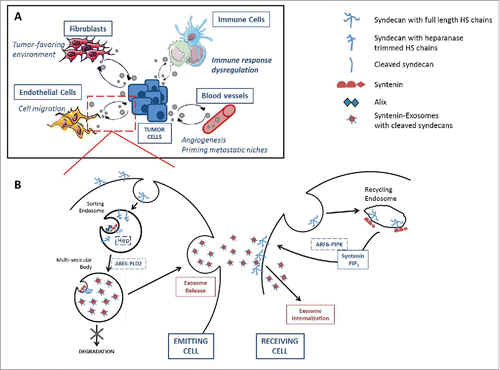Figures & data
Figure 1. The syndecan-syntenin-ALIX pathway in intercellular exosomal communication. (A) Exosomes are mediators of intercellular communication between tumor and host cells including fibroblasts, endothelial cells, blood vessels and immune cells, to either favor or suppress the tumorigenic process depending on the cancer setting. Both host and tumor cells secrete and uptake exosomes and this multidirectionality seems to be regulated in part by the syndecan-syntenin pathway as detailed in (B). Syntenin binds to the cytosolic tail of syndecans, which are internalized in sorting endosomes along with their intact heparan sulfate (HS) chains. Endosomal heparanase (Hep) processes the HS chains to allow the clustering of syndecans for recruitment by syntenin to the ALIX/ESCRT machinery. Exosomal syndecans consist mainly of cleaved forms, i.e. C-terminal fragments of these molecules.Citation6 Along with ARF6 and phospholipaseD2 (PLD2), they trigger the formation of multi-vesicular bodies, containing several endosomes, later released as exosomes. On the target cell, syntenin is also involved in maintaining a pool of HSPGs at the cell membrane, by stimulating their recycling, in their intact full form, via its direct interaction with phosphatidylinositol 4,5 bisphosphate (PIP2), depending on ARF6-phosphatidylinositol 4-phosphate 5-kinase (PIPk) activation. HSPGs presence is essential for efficient exosome internalization and function.

